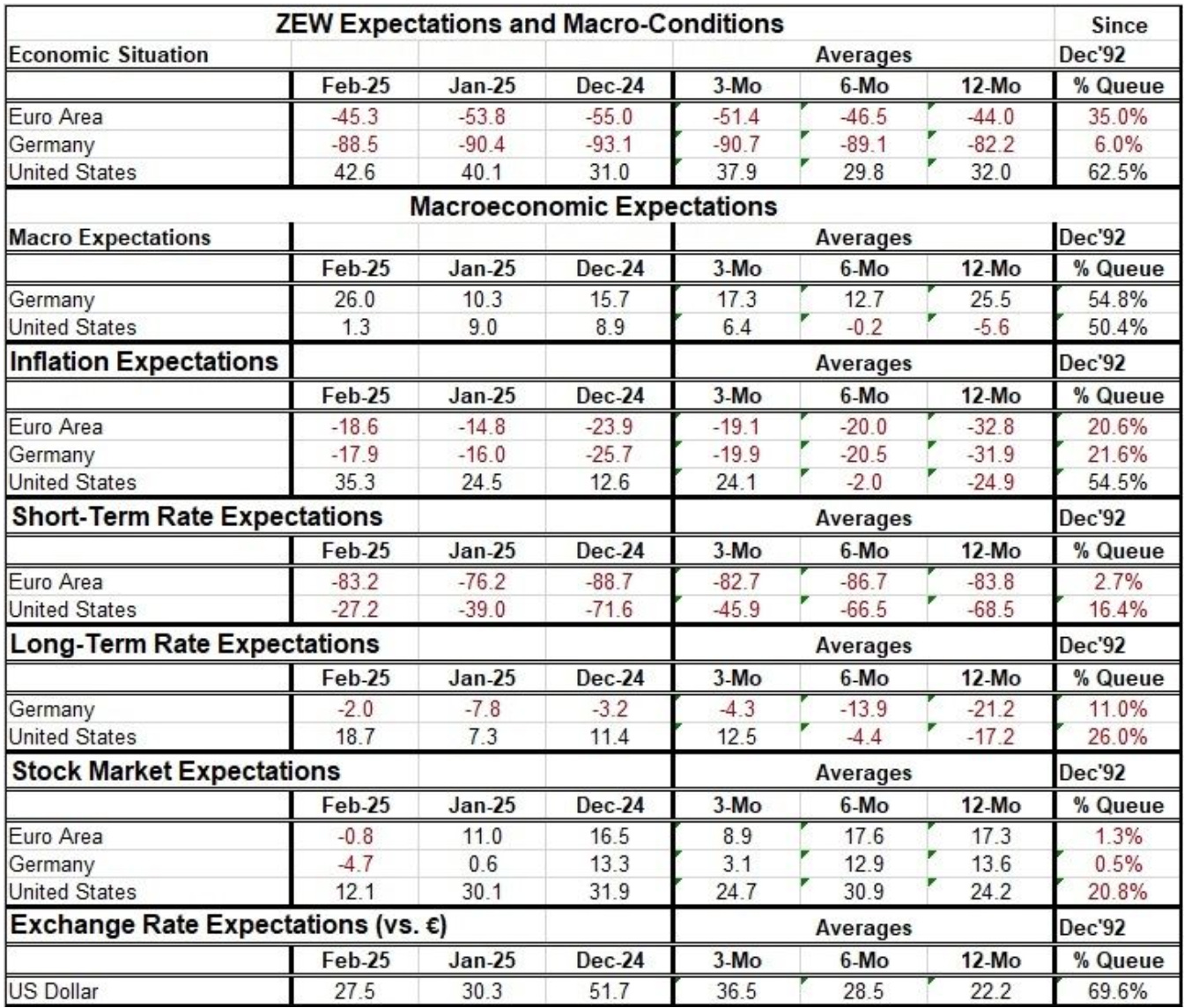Improved macro outlook
The ZEW financial experts in February see improved conditions in Germany, perhaps just in time to affect the German elections that are due. Macro-expectations for Germany in February moved up to 26.0 from 10.3 in January while U.S. expectations backtracked to 1.3 in February from 9 in January. German expectations have a 54.8 percentile queue standing on data since 1992; the standing for the United States reading on the same timeline is 50.4%.
The macroeconomic expectations for the U.S. and for Germany are very different in terms of diffusion readings in February; however, their percentile standings are surprisingly similar. The diffusion reading is a raw better minus worse reading while the percentile reading ranks the current value against a historic queue of observations. The lesser expansionary reading for the U.S. compares historically about as favourably to past data as does the comparison of the stronger German diffusion reading to its past data.
Current situation still floundering
However, the economic situation continues to be very different in Europe and in the United States. The readings for the euro area, Germany, and the United States all improved in February, but by small amounts.
For the euro area, there's an improvement to -45.3 in February from -53.8 in January.
For Germany, the improvement is to -88.5 in February from -90.4 in December.
In the U.S., it's another small improvement but from 40.1 in January to 42.6 in February.
U.S. is logging substantial positive reading, compared to quite deeply negative diffusion readings in the euro area and in Germany. This is made clear by looking at the queue percentile standings for the EMU for February; it is at its 35th percentile, the standing for Germany is at its 6th percentile, and the standing for the United States is at its 62.5 percentile – a world of difference there.
Inflation expectations
Inflation expectations are mixed in February, but the euro area in Germany shows weak inflation readings and some tendency for expectations to see inflation even weaker. In the U.S., the inflation readings are positive in diffusion terms and much closer to normal levels. The queue percentile standings for the euro area are around the 20th percentile; the same is true of Germany at its 21st percentile. For the U.S., there is a 54th percentile standing above its historic median- a world of difference in the standings.
Interest rate expectations
These differences play out across interest rate expectations as well, but not quite as strongly. The diffusion readings for short-term interest rate expectations find more deeply negative readings in the euro area, -83.2 in February, compared to its -76.2 in January.
These readings compare to the U.S. in February at a -27.2 reading, a substantially less negative result than the -39 reading in January. U.S. readings have been progressing more rapidly toward zero as the December reading for the U.S. was set at -71.6.
The queue standing for the U.S. reading was a 16.4 percentile standing for short-term interest rates.
The queue standing for the euro area is at a 2.7 percentile standing.
Despite the great difference in the diffusion readings, the queue percentile standings for each of them are basically readings in the same extremely weak region. Long-term rate expectations show Germany with a -2 diffusion value in February compared to -7.8 in January; for the U.S., the February reading moved up to 18.7 from 7.3 in January. The German negative numbers are moving up, toward zero, while the U.S. positive numbers are getting higher, so both Germany and the U.S. see long-rate expectations moving in the same direction.
The German queue standing for its rate expectation in February is an 11-percentile standing while the U.S. queue standing at a 26-percentile standing is higher, but both of them are relatively weak standings, both of them well below their historic medians.
Stock markets
Stock market expectations are weak across the board with the euro area queue standing at 1.3%, exceptionally weak. The German queue standing manages to get below that at 0.5%. U.S. stock market standings are better on a ranking basis but still not very good at the 20.8 percentile standing; they're well below the 50th percentile which marks their median.
However, the diffusion reading in U.S. stocks is positive at 12.1; for Germany it's -4.7 and for the euro area it's -0.8; all of these reflect relatively sharp deteriorations from levels in January or December.
Summing up
In addition to the ordinary ebb and flow of economic data and shifting expectations, what we have here also is a reaction to the new announcements and policy plans of the Trump administration.
After it's late in the month aggressive dressing down of European leaders, we can only wonder how expectations are going to shift next month when that gets fully reflected in data. Despite the fact that we all know that Trump now is the U.S. President, there still is not a great deal of consensus about what he's going to do, and how that's going to work its way out across the international arena, what impact it might have on Federal Reserve policy, or the impact it will have on the fiscal policy across governmental agencies.
Foreign policy is also in the mix of uncertainty, and there's a great deal of anxiety about Trump's plans for ending the Russia-Ukraine war. Stay tuned for all of this as we get more information on Trump and also as markets prepare for upcoming German elections.
An Economic Letter series is part of the information package members of Investing by Design will have access to. Click on the button above for more information and to become a member.





